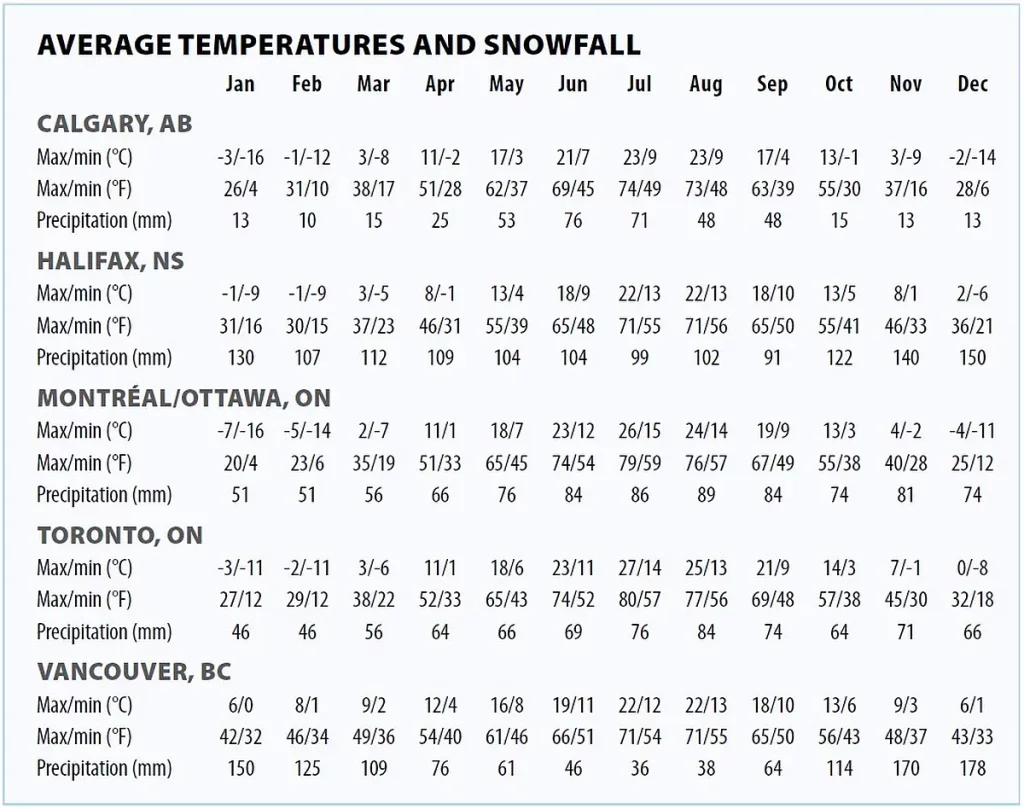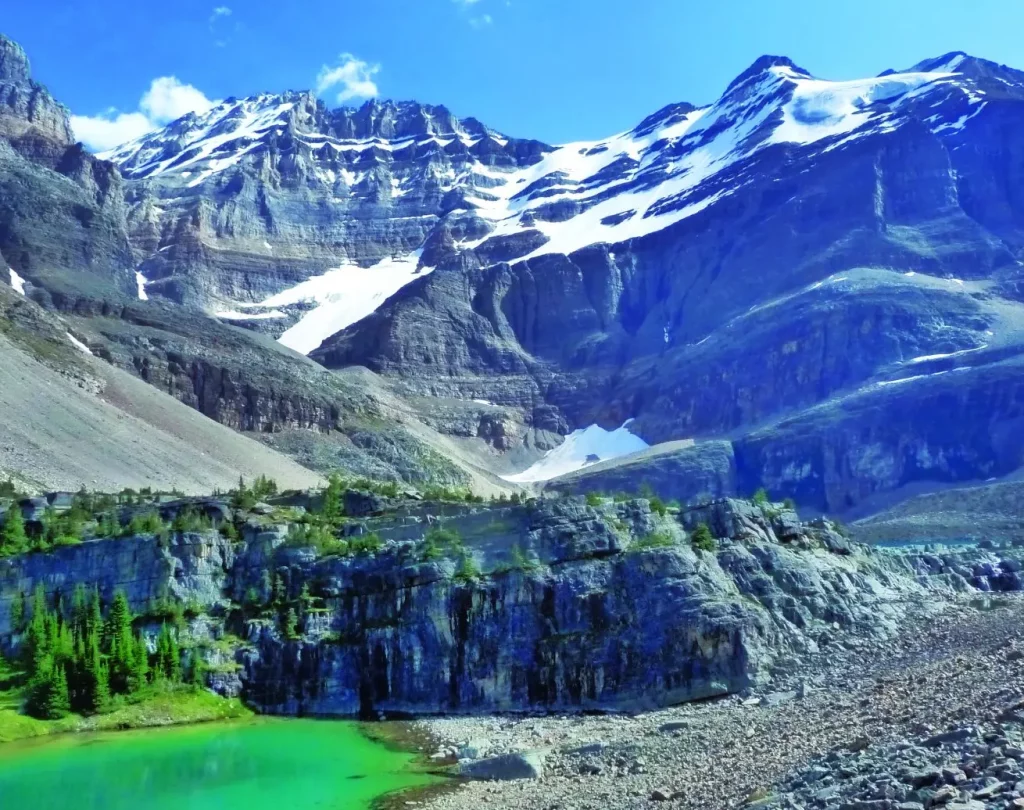Introduction
There’s no doubt that Canada is a country with extreme weather. From the harsh winters in the north to the hot summers in the south, Canadians must deal with various temperatures and conditions throughout the year. But what exactly is the difference between weather and climate? And how does Canada’s climate compare to other countries around the world? This blog post will explore these questions and more, giving you a better understanding of Canada’s weather and climate.
Canada’s winter and high summer temperatures vary by region. Winters are notoriously harsh in most of the country, with parts of the central and Prairie provinces experiencing a continental climate. In these regions, high daily temperatures typically range between −15 °C (5 °F) to −40 °C (−40 °F), though it can sometimes drop below −40 °C (−40 °F). Meanwhile, British Columbia has a temperate climate, with an average high temperature of 20s °C (68-70 degrees Fahrenheit). At the coastlines, average high summer temperatures range from 25 to 30 °C (77 to 86 degrees Fahrenheit), but in some interior areas, they can exceed 40 °C (104 degrees Fahrenheit).
The temperature in Canada has increased significantly due to the country’s polluting industry. Annual average temperatures are now higher than in over one century, with regional changes ranging from 1.1 to 2.3°C (2.0 to 4.1°F). The North and the Prairies have seen the most significant increase, at 3 times the global annual average. Canadian fisheries are also threatened by ocean acidification and the warming of seawater, which is hurting aquaculture productivity and fisheries in Canada’s coastal communities.
The climate
Canada has great geographical diversity, and the climate varies widely from region to region. Generally speaking, the climate in Canada can be divided into four main types: Continental, Maritime, Highland, and Arctic. Most of the Canadian population lives in the Continental and Maritime climate zones.
Continental Climate
- The Continental Climate is found in the southern parts of the Prairie Provinces (Alberta, Saskatchewan, and Manitoba) and parts of British Columbia‘s interior.
- This climate is characterized by warm summers and cold winters.
- The average winter temperature is -15°C, while the average summer temperature is 20°C.
Maritime Climate
- The Maritime Climate is found along the west coast of Canada, from Vancouver Island to Newfoundland. It is also found along the southeast coast of Nova Scotia.
- This climate is characterized by cool summers and mild winters. The average winter temperature is 0°C, while the average summer temperature is 15°C.
Highland Climate
- The Highland Climate is found in small pockets throughout the country, generally at high elevations (such as in parts of Alberta, British Columbia, Yukon, and Nunavut).
- This climate is characterized by cool summers and cold winters. The average winter temperature is -10°C, while the average summer temperature is 10°C.
Arctic Climate
- The Arctic Climate is found in the northernmost parts of the country, including the Northwest Territories, Nunavut, and parts of northern Quebec and Labrador.
- This climate is characterized by long, cold winters and short, cool summers. The average winter temperature is -30°C, while the average summer temperature is 0°C.
Averages
Two major Canadian cities fall outside the continental climate schema: Vancouver and Victoria. Vancouver experiences an oceanic climate, bordering on a warm-summer Mediterranean in the summer, and has a relatively marked dry season. Victoria, BC, is the only major city in Canada with a warm-summer Mediterranean climate. Ottawa, Montreal, and Toronto have the warmest summers in Canada, while Winnipeg has the coldest winters: these three are also the largest Canadian cities. Vancouver’s winters are milder than any other major city in Canada.

There is a huge variation in the temperatures in Canada because of all the different elevations. For example, some small towns in southern British Columbia just outside of Vancouver have a humid continental climate Dfb with average winter temperatures and cold snaps comparable to other parts of the country.
Subarctic and arctic climates are seen in northern Canada. These areas are so barren that they have low populations. The harsh climate, where temperatures can drop below -20°C (-4F) during the winter and stay below 0°C for most of the summer, has severely limited these regions’ growth and population density.
Some mountain passes in southern BC have a subarctic climate, which can make driving conditions very dangerous. If you’ve come from Vancouver or Kamloops, it’s easy to forget how cold the roads can get.
The weather
The weather in Canada can be described as highly variable and unpredictable. The country experiences a wide range of climate conditions, from the cold winters in the north to the warm summers in the south.
Canada has four main seasons: winter, spring, summer, and fall. Winter typically lasts from December to February, while spring runs from March to May. Summer usually extends from June to August, and fall lasts from September to November.
Within each season, there can be significant variations in temperature and precipitation levels from one region to another. For example, southern Ontario generally has milder winters than northern Quebec or the Prairie provinces. Similarly, coastal British Columbia experiences much wetter conditions than inland regions like Alberta or Saskatchewan.
The complexity of the weather and climate
Because of its vast size and diverse topography, Canada is home to various weather patterns. From the humid continental climate of the east coast to the dry prairie plains of the west.
Canada’s weather and climate are diverse entities, with long-term averages of complicated weather patterns. Canada’s landscapes range from lush rainforests to barren scrappy tundra. From arid deserts to fertile fields. From luscious peach orchards to salty windstorms.
Factors like latitude, elevation, slope, pressure and wind patterns, water features, and the orientation of major landform feature all contribute to how our climate behaves. For instance, in the low-lying area of White River in Ontario, cool evening air settles down around slopes to create a frost hollow that averages over 300 days per year.
This is because, due to Canada’s northern latitude, sun rays hit the earth’s surface at a low angle in the winter months, resulting in long and cold winters. Conversely, summer months are short and warm but not hot. The influence of height on the country’s climate can also be seen; for instance, higher altitudes often have more rainfall than lower altitudes. We see this happening in the Canadian mountains as well – these reach as high as elevations of 2200 meters. Consequently, they act as an effective barrier against moist Pacific air masses from entering Canada ́s interior. These many ranges also result in cooler temperatures at higher altitudes – making them attractive vacation spots during the summer months.

Canada’s flat prairies make them susceptible to Arctic cold winds in the winter and hot, dry southwesterly winds in the summer. However, the chinook winds (warm, dry air that comes down from the Rocky Mountains) can change this susceptibility in a short time.
The Canadian Shield is a saucer-shaped area of land that dominates central Canada. Hudson Bay, the Shield’s core, is dominated by bogs, lakes, and rocky outcroppings. Airflow over these large bodies of water is minimal, thanks to their rugged landscape.
Lakes make significant differences in the climate, and that’s because water takes longer to heat up than land. And once it’s heated up, it stays warm for a long time. As a result, large bodies of water, such as the Great Lakes, moderate the climate of Canada’s south and east coasts. They help keep those areas slightly warmer, especially during our cold Canadian winters.
Canada’s west coast generally has mild weather and is humid. The prevailing winds of the west coast are gentle and carry moisture from the Pacific to the region. Meanwhile, Canada’s east coast gets less humid weather from the continent’s interior. Eastbound winds that hit the shore also carry frigid air from the Labrador Current. The current brings in conditions of cold temperature and high humidity, which combine to create bone-chilling weather.
There’s not much to warm the Arctic Ocean of Canada’s north, but the ice that drifts and stretches over the ocean helps keep temperatures from getting as cold as they would be on land. In warmer months, from June to August, a kind of fog forms over breaks in the pack ice in the form of ice fog and Arctic “sea smoke.”
Temperature ranges in different locations vary greatly. The average annual temperature range is figured by subtracting the average temperature of the coldest month from the average temperature of the warmest month. Taking Alaska, for example, the annual temperature range is 104°F (58°C), compared to 50°F (28°C) for California. The typical annual temperature range is 95°F (53°C) in Canada’s Prairie Provinces, 86°F (48°C) along the Great Lakes-St. Lawrence Seaway region, and 73 °F(41 °C) for Atlantic Maritimes.
Precipitation is heaviest in the west, in British Columbia, and along the coast of Canada. Rainfall can exceed 90 inches (229 centimeters) in these areas annually. Meanwhile, precipitation levels are lower elsewhere, such as in southeastern Alberta. The amount of rain also varies geographically and over time because arid regions experience periods without any rainfall, polar deserts receive very little rain even during rainy seasons, and desert oases near Osoyoos in British Columbia have a moderate climate that rarely faces any natural hazards.
Along with the precipitation and sunshine Canada receives, the country is ventilated by winds of varying strength, temperature, and humidity. Many tales of early peoples are filled with images of local winds. Some names refer to the origin or destination of the wind, some describe the coldness or warmth of the air, while others are descriptive of either pleasant or trying times. Additionally, Canada experiences thunderstorms, tornadoes, blizzards, and occasional hurricanes. So perhaps it’s more appropriate to speak of the climates of such an immense country as Canada.
The seasons
Canada has four distinct seasons: winter, spring, summer, and fall. Each season brings its unique weather patterns and climate conditions.
- Winter in Canada is typically cold and snowy. The average temperature in winter is around -15°C.
- Spring is a transitional season, with the weather becoming warmer and snow melting. The average temperature in spring is around 5°C.
- Summer is the warmest season in Canada, with an average temperature of 20°C.
- Fall is also a transitional season, with the weather becoming more relaxed and the leaves changing color. The average temperature in the fall is around 10°C.
Conclusion
Overall, Canada has a lot of variety regarding weather and climate. Depending on where you are in this great country, you could experience anything from scorching hot summers to cold winters. But no matter what the weather is like, there’s always something to do in Canada! So whether you’re looking to hit the slopes or lounge on the beach, pack appropriate clothing for whatever Mother Nature throws your way.
